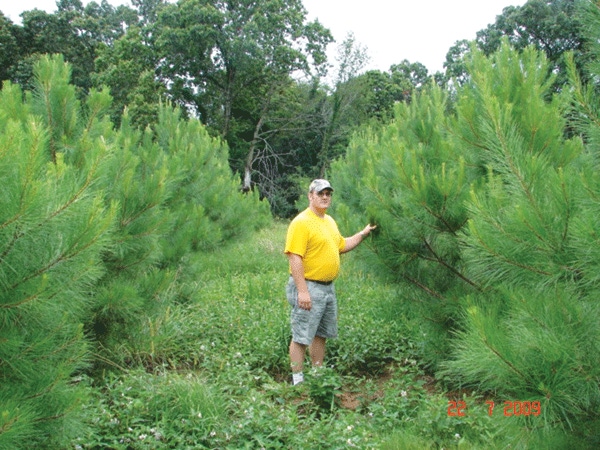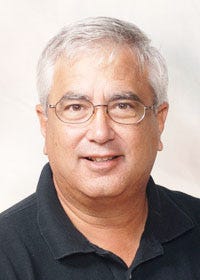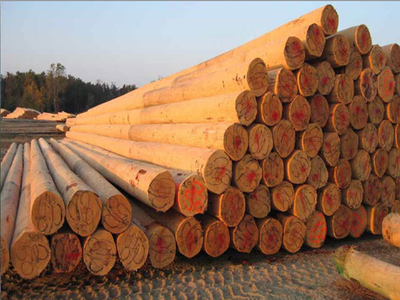
Genetically superior pine seedlings can increase timber value for southern landowners through faster growth rates, greater adaptability, increased disease resistance, improved wood properties, and superior form, says Randall Rousseau, Mississippi State University associate Extension/research professor.


RANDY ROUSSEAU
Planting genetically superior pine seedlings along with sound silvicultural treatments could enhance the value of a landowner’s future trees by as much as 100 percent compared to the more common open pollinated trees, says Mississippi State University Associate Extension/Research Professor Randall Rousseau.

AT AGE 4, performance of genetically improved pines shows increased growth rates over unimproved trees.
For more than 15 years, forestry ranked No. 2 in the Mississippi’s agriculture, behind poultry/eggs, before being pushed into third place in 2012 by soybeans. Even so, the 2012 value of the state’s forest products is estimated at $1.03 billion, up from $957 million the previous year. Processing harvested timber into products, such as lumber, paper, and wood furniture, resulted in an economic impact to the state of more than $10 billion in sales and contributed to more than 63,000 jobs.
Many of the state’s row crop farmers also have timber acreage that is predominantly pines.
In the southern U.S., more than 30 million acres of loblolly pine plantations have been planted, Rousseau, who is also a forest geneticist at the MSU Forest and Wildlife Research Center, said at the annual meeting of the Oktibbeha County Forest Farmers Association at Crawford, Miss.
“The vast majority of those acres have been planted with genetically improved stock,” he said. “Some of the most sophisticated pine programs in the world are located in the southeastern U.S., and improved seed, seedlings, and trees have proven their worth for nearly 40 years.”
In the past 60 years, he said, pine tree improvement “has moved from obscurity to the forefront of industrial programs,” and today more than 1 billion loblolly pine seedlings are planted each year — almost all the product of a tree improvement program.
Ag news delivered daily to your inbox: Subscribe to Delta Farm Press Daily.
“Genetically superior seedlings increase timber value because of their faster growth rates, greater adaptability, increased disease resistance, improved wood properties, and superior form,” Rousseau says.
Better economic gains

PEELED PINE LOGS show a high degree of uniformity of genetically improved varieties at harvest.
Economic gains for trees grown from first generation seedlings are estimated at 15 percent to 20 percent over unimproved stands. Gains from second generation parents have nearly doubled those of the first generation parents. And recent analyses indicate that full-sibling families from the best second generation parents can produce volume gains of over 50 percent.
But Rousseau says, genetically improved seedlings from controlled pollination families have shown potential for a return of $883 per acre compared to $399 for first generation open pollinated trees and $657 per acre for second generation open pollinated trees.
“In every situation,” he says, “these pine genetics and tree improvement programs are utilizing cutting edge technology in genetics and silviculture to produce faster-growing quality timber.”
But he says, “The full genetic potential of the best genetic material can only be realized if sufficient resources are allocated to growing the trees.”
The choice of what to plant will depend on the landowner’s resources and objectives, Rousseau says, and it’s important to understand the various types of genetically-improved seedlings available and the costs involved in planting them.
Developing genetically superior seedlings is a multi-step process he says. “In essence, the process of tree improvement is straightforward: Find good parent trees, select them, bring them together for mating, test the offspring, select the best performers, and then start the process all over.”
However, this simplified process hides all of the extensive research needed to maintain viable large diverse breeding populations, wide-scale testing, development of genetic tools, and processes needed to produce the seed and seedlings for production plantings.
Genetically improved seedlings can be bred for rapid growth rates, straightness, disease resistance, cold resistance, small compact crowns, and drought tolerance. They can be first, second, or third generation open pollinated, mass control pollinated from second or third generation or selected genotypes, or varietals (which are clones derived from either somatic embryogenesis or hedging).
Exceptional gains

SUPERIOR PERFORMANCE is demonstrated by genetically improved pines in nursery trials.
“Until recently, pine programs have not had the luxury of using clones produced through vegetative propagation,” Rousseau says. “But this method allows exceptional gains because all of the inherent genetic variation can be captured. The special advantage of somatic embryogenesis is that once thoroughly tested individuals are found that combine the desired traits being sought, it can be rapidly multiplied, with each individual being genetically identical to the selected tree.”
Varietal pine, the term given to the development of pine clones, is currently the top genetic level of pine tree improvement today, he notes.
“Although this is expensive — seedlings produced with this method cost about $435 per 1,000 — they provide the grower with the highest quality genetic material available.”
While more acres are being planted each year to mass control pollinated and varietal seedlings, Rousseau says, “Before planting, landowners should be fully aware of how these advanced genetic seedlings perform in their general area in order to realize the genetic potential.”
Ag news delivered daily to your inbox: Subscribe to Delta Farm Press Daily.
To develop more information about how these genetically superior trees will perform, he says cooperative landowners are being sought for a statewide committee that would meet a couple of times yearly, make on-site visits, and evaluate recommendations. There would also be an online forum for questions and discussion, as well as providing information about how landowners can take advantage of genetics currently on the market.
About the Author(s)
You May Also Like



